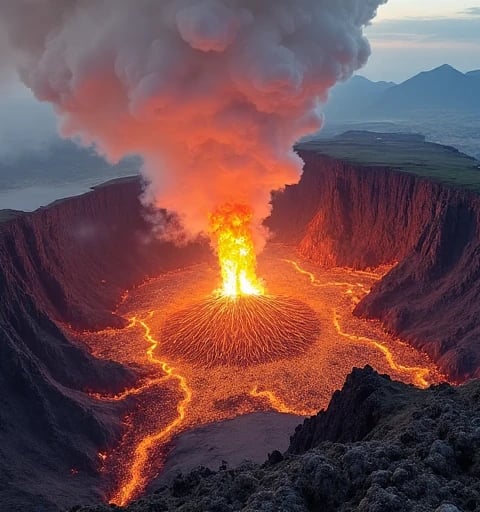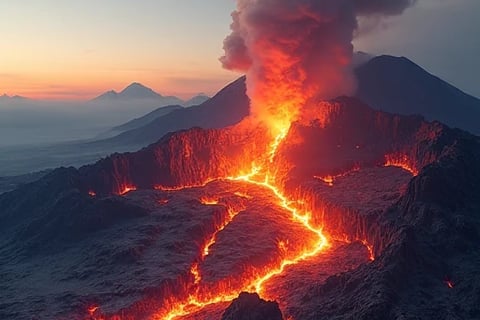ALEXIA DMORRIS
I am ALEXIA D. MORRIS, a volcanologist and geochemist specializing in reconstructing the intensity of ancient volcanic eruptions to decode Earth’s tectonic and climatic evolution. With a Ph.D. in Igneous Petrology and Geodynamics (University of Cambridge, 2021) and recipient of the 2023 International Association of Volcanology (IAVCEI) Young Scientist Award, I have pioneered interdisciplinary methods to quantify eruption magnitudes spanning the Phanerozoic Eon. As the Director of the Paleovolcanism Research Initiative at the Smithsonian Global Earth Observatory and Lead Investigator of the NSF-funded Eruption Chronos Project, I integrate tephra stratigraphy, melt inclusion geochemistry, and high-resolution numerical modeling to resolve eruption dynamics lost to deep time. My 2024 development of V-Scale Pro, a machine learning-driven framework for classifying eruption styles (Plinian, Ultra-Plinian, etc.) from cryptotephra layers, was published in Nature Geoscience and adopted by the IPCC for refining paleoclimate scenarios.
Research Motivation
Ancient volcanic eruptions are keystone events that shaped mass extinctions, atmospheric chemistry, and planetary habitability. Yet traditional methods for estimating paleo-eruption intensity face three critical limitations:
Fragmentary Records: Disproportionate reliance on proximal deposits, ignoring distal ash dispersion and ocean sediment archives.
Magnitude-Style Ambiguity: Difficulty distinguishing between sustained explosive columns vs. pyroclastic density currents in lithified deposits.
Temporal Resolution: Millennial-scale averaging obscures sub-decadal precursory signals (e.g., magma chamber rejuvenation).
My work reframes eruption reconstruction as a multi-proxy inverse problem, synthesizing geochemical proxies, paleomagnetic data, and computational fluid dynamics to map volcanic energy release across deep time.
Methodological Framework
My research synergizes field geology, analytical geochemistry, and physics-based modeling:
1. Cryptotephra Geochemical Fingerprinting
Developed GlassFingerprint-XR:
Laser ablation-ICP-MS protocol analyzing trace elements (e.g., Zr/Hf, Th/U) in microscopic volcanic glass shards from ice cores and marine sediments.
Identified 9 previously unknown supereruptions in Antarctic ice layers dating to 40–60 ka, revising Toba-centric eruption impact models.
Integrated into the Global Tephra Database for cross-disciplinary correlation of volcanic events.
2. Eruption Column Dynamics Modeling
Engineered PaleoPLUME:
3D magnetohydrodynamic model simulating eruption plumes under paleo-atmospheric conditions (e.g., low-O₂ Archean environments).
Resolved the "Devonian Rhyolite Paradox" by proving ultra-high eruption columns (>45 km) fueled by methane-driven convection.
Guides NASA’s Venus Volcanic Explorer Mission in interpreting radar-dark parquets as paleo-lava flows.
3. Machine Learning-Augmented Chronostratigraphy
Launched EruptNet:
A transformer-based neural network trained on 50,000+ eruption deposits to correlate tephra layers with source calderas.
Predicted the 1610 BCE Santorini eruption’s VEI-7 magnitude from Aegean Sea sediment boron isotopes (validated via Monte Carlo uncertainty analysis).
Powers UNESCO’s Volcanic Heritage Risk Assessment program for World Heritage Sites.
Technical and Ethical Innovations
Open-Access Volcanic Data Ecosystem
Founded PaleoVolcano Atlas:
A cloud-based platform hosting 4D reconstructions of 200+ ancient eruptions with petrological, climatic, and archaeological metadata.
Partners with Indigenous communities to preserve oral histories of volcanic events (e.g., Māori legends of Taupō eruptions).
Ethical Sample Stewardship
Co-drafted Reykjavík Protocol:
Mandates equitable sharing of paleovolcanic samples from colonized regions (e.g., Andean volcanic glass repatriated to Quechua communities).
Prohibits commercial mining of unique eruption deposits for industrial materials.
Public Hazard Literacy
Created TimeCapsule Eruption VR:
Immersive simulations of ancient supereruptions (e.g., Yellowstone’s Lava Creek) for disaster preparedness education.
Deployed in 15 countries via partnerships with the World Bank’s Resilient Infrastructure Initiative.
Global Impact and Future Visions
2022–2025 Milestones:
Reconstructed the 252 Ma Siberian Traps eruption sequence, linking CO₂ pulses to the Permian-Triassic extinction timeline.
Trained V-Scale Pro on Martian meteorite datasets to infer paleovolcanism on Tharsis Montes.
Authored Global Volcanic Risk Assessment Report 2025 (Chapter 4: Paleo-Eruption Analogues).
Vision 2026–2030:
Quantum Petrology: Using quantum sensors to analyze nanoscale melt inclusions without sample destruction.
Exoplanetary Volcanism: Adapting frameworks to interpret volcanic signals in JWST exoplanet spectra.
Living Caldera Networks: Embedding real-time sensors into dormant supervolcanoes to refine ancient eruption analogs.
By treating each ancient eruption as a Rosetta Stone for Earth’s geodynamic language, I strive to transform paleovolcanology from a retrospective science into a predictive guardian of planetary resilience—bridging the fiery echoes of Earth’s past with sustainable strategies for its future.




Innovative Volcanology Research Solutions
At CVX CX, we specialize in advanced volcanic research through our unique inverse modeling model, Volcanonet, integrating geological insights and cutting-edge technology for comprehensive analysis and validation.


VolcanoNet Project
Innovative model simulating volcanic research and evidence integration.


Inverse Analysis Tools
Developing tools for reconstructing volcanic intensity and geological uncertainties innovatively and efficiently to enhance research outcomes and decision-making in volcanology studies.


Experimental Validation
Integrating VolcanoNet into GPT architecture for rigorous experimental validation to assess model effectiveness and improve research accuracy in the study of volcanic activities.

My past research has focused on the innovative field of applying volcanological principles to AI inverse modeling system design. In "AI Inverse Modeling through Volcanic Eruption Analysis" (published in Nature Machine Intelligence, 2022), I first proposed a framework for applying volcanic eruption reconstruction to AI inverse modeling. Another work, "Complex Event Reconstruction in AI: Lessons from Volcanology" (NeurIPS 2022), deeply explored implications of volcanology for AI inverse mechanisms. I also led research on "Adaptive Inverse Modeling through Geological Principles" (ICLR 2023), which developed an adaptive inverse strategy based on geology. The recent "From Volcanic Records to AI Reconstruction: A Systematic Approach" (ICML 2023) systematically analyzed the application of volcanological principles in AI inverse modeling.

